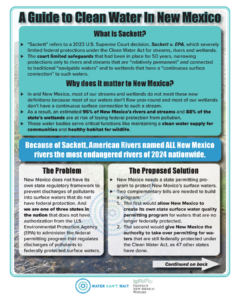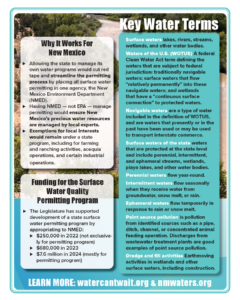Read below to learn about the Sackett decision — what it is, how it impacts New Mexico, and proposed solutions to protect our state’s surface waters. You can also download/view a PDF version of our Guide to Clean Water in New Mexico.
 What is Sackett?
What is Sackett?
“Sackett” refers to a 2023 U.S. Supreme Court decision, Sackett v. EPA, which severely limited federal protections under the Clean Water Act for streams, rivers and wetlands.
The court limited safeguards that had been in place for 50 years, narrowing protections only to rivers and streams that are “relatively permanent” and connected to traditional “navigable waters” and to wetlands that have a “continuous surface connection” to such waters.
Why does it matter to New Mexico?
- In arid New Mexico, most of our streams and wetlands do not meet these new definitions because most of our waters don’t flow year-round and most of our wetlands don’t have a continuous surface connection to such a stream.
- As a result, an estimated 95% of New Mexico’s rivers and streams and 88% of the state’s wetlands are at risk of losing federal protection from pollution.
- These water bodies serve critical functions like maintaining a clean water supply for communities and healthy habitat for wildlife.
Because of Sackett, American Rivers named ALL New Mexico rivers the most endangered rivers of 2024 nationwide.
The Problem
New Mexico does not have its own state regulatory framework to prevent discharges of pollutants into surface waters that do not have federal protection. And we are one of three states in the nation that does not have authorization from the U.S. Environmental Protection Agency (EPA) to administer the federal permitting program that regulates discharges of pollutants to federally protected surface waters.
The Proposed Solution
New Mexico needs a state permitting program to protect New Mexico’s surface waters.
Two complementary bills are needed to build a program:
1. The first would allow New Mexico to create its own state surface water quality permitting program for waters that are no longer federally protected.
2. The second would give New Mexico the authority to take over permitting for waters that are still federally protected under the Clean Water Act, as 47 other states have done.
Why it works for New Mexico
Allowing the state to manage its own water programs would cut red tape and streamline the permitting process by placing all surface water permitting in one agency, the New Mexico Environment Department (NMED).
- Having NMED — not EPA — manage permitting would ensure New Mexico’s precious water resources are managed by local experts.
- Exemptions for local interests would remain under a state program, including for farming and ranching activities, acequia operations, and certain industrial operations.
Funding for the Surface Water Quality Permitting Program
The Legislature has supported development of a state surface water permitting program by appropriating to NMED:
- $250,000 in 2022 (not exclusively for permitting program)
- $680,000 in 2023
- $7.6 million in 2024 (mostly forpermitting program)
Developed in partnership with Protect New Mexico Waters.


